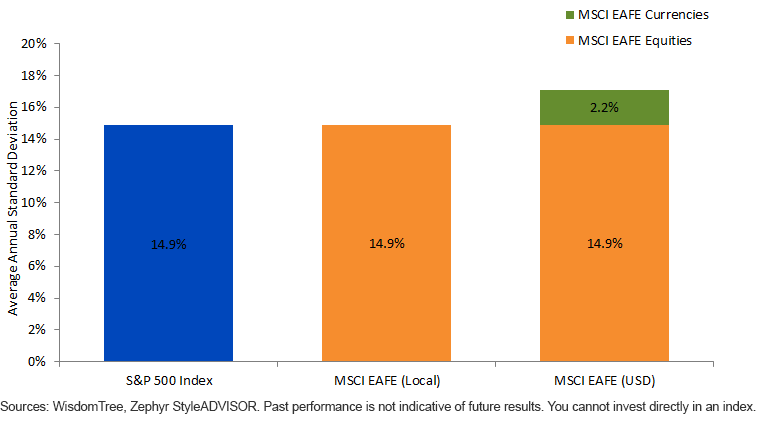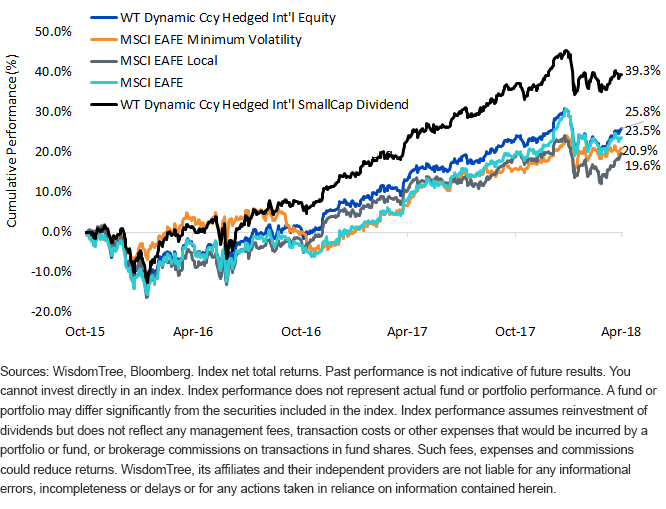Why Min Vol International Indexes Focus on the Wrong Factor


Of all the smart beta equity factors that have resonated with investors and garnered the most assets, minimum volatility stands out. In the developed international world, the leading minimum volatility (min vol) ETF has garnered almost $9 billion in assets in a relatively short period.
One issue with minimum volatility factor investment approaches is that the inputs into these indexes are backward-looking optimizations with no sensitivity to valuation. This is a critique that can be leveled against many smart beta factors that crowd into these types of stocks and can lead to more extended valuation multiples.
Looking at valuations on international low-volatility stocks today, I see min vol stocks trading at a premium multiple to the markets. According to Bloomberg, the MSCI EAFE Minimum Volatility Index has a trailing 12m price-to-earnings (P/E) ratio of 17.1x this year’s estimated earnings, while the MSCI EAFE Index has an estimated P/E ratio of 14.5x.1
When MSCI created the min vol index series, it used an optimization function that looks at U.S. dollar returns and targets the lowest volatility with constraints to country and sector allocations. One complicating factor internationally is that there are both local market stock returns and currency returns. For example, due to the yen’s negative correlation to Japanese equities, an optimization that includes currency exposure would allocate more weight to Japan, despite Japanese stocks in local FX terms potentially having much higher volatility than broader international markets.
A Different Way to Lower Volatility
WisdomTree has been advocating that currency exposure layered on top of equity risk adds to the volatility profile of broad-based international investments but not expected returns—with the Japanese yen and Swiss franc being the two primary outliers to that story. We believe another way to lower volatility, broadly, is to focus on stock exposure while mitigating the net exposure to currency risk.
We have found that, over the last 30 years, currency exposure raised the volatility to MSCI EAFE, a broad international index, by more than 200 basis points (bps) a year and resulted in these international stocks, which by themselves had the same volatility as the S&P 500, becoming a higher-volatility asset class.
S&P 500 Index and International Equity (3/31/86–3/31/18)

We believe that a better way to gain exposure to lower-volatility international investments is to either strategically hedge a broad international basket or implement a dynamic hedge, using a quantitative process that can also add to expected returns.
WisdomTree launched a dynamically hedged index family that we believe captures the primary volatility-reduction benefits but can outperform both hedged and unhedged benchmarks over longer-term cycles.
In the 2.5 years our core broad-based Index has been live, we have found that the WisdomTree Dynamic Currency Hedged International Equity Index was able to result in similarly low volatility as the MSCI EAFE Min Vol Index while providing meaningful value added over those stocks (see chart below).
In the live period since the launch of the WisdomTree dynamically hedged Indexes, the min vol factor has not added value from a stock selection basis when comparing the unhedged MSCI Min Vol Index to the unhedged MSCI EAFE Index. A factor that we have found to be a value add both in the last 2.5 years and also fairly consistently over the last 10 years has been a tilt to international small-cap stocks. The WisdomTree Dynamic Currency Hedged International SmallCap Equity Index outperformed our dynamically hedged broad market Index by 13.5%.
International Equities' Cumulative Performance (10/30/15–4/30/18)

In contrast to the minimum volatility factor, which is selling at a premium to the MSCI EAFE Index, the WisdomTree International SmallCap Dividend Index is currently at a marginal discount, at 14.1x this year’s earnings.
While I believe the goal of the MSCI minimum volatility indexing construct is a worthy one and that clients inherently desire an element of risk management when it comes to venturing into overseas equities, I believe managing currency risk directly could be a better risk management protocol than the traditional minimum variance index construct. Min vol indexes created meaningful stock selection risk that did not pay off over the last few years, when a direct currency risk management program could have equally lowered the volatility profile of international investments without making big country or sectors bets.
We do not believe the low-volatility factor is an alpha-generating factor, but rather a risk management practice, and that risk management can be achieved by hedging currencies. WisdomTree believes our dynamic FX hedging algorithms can be both an alpha-generating factor process and a risk management practice. We apply this approach to core international equities, small-cap equities and quality-based factor portfolios.
1Source: Bloomberg, as of 4/30/18.

Jeremy Schwartz has served as our Global Chief Investment Officer since November 2021 and leads WisdomTree’s investment strategy team in the construction of WisdomTree’s equity Indexes, quantitative active strategies and multi-asset Model Portfolios. Jeremy joined WisdomTree in May 2005 as a Senior Analyst, adding Deputy Director of Research to his responsibilities in February 2007. He served as Director of Research from October 2008 to October 2018 and as Global Head of Research from November 2018 to November 2021. Before joining WisdomTree, he was a head research assistant for Professor Jeremy Siegel and, in 2022, became his co-author on the sixth edition of the book Stocks for the Long Run. Jeremy is also co-author of the Financial Analysts Journal paper “What Happened to the Original Stocks in the S&P 500?” He received his B.S. in economics from The Wharton School of the University of Pennsylvania and hosts the Wharton Business Radio program Behind the Markets on SiriusXM 132. Jeremy is a member of the CFA Society of Philadelphia.

